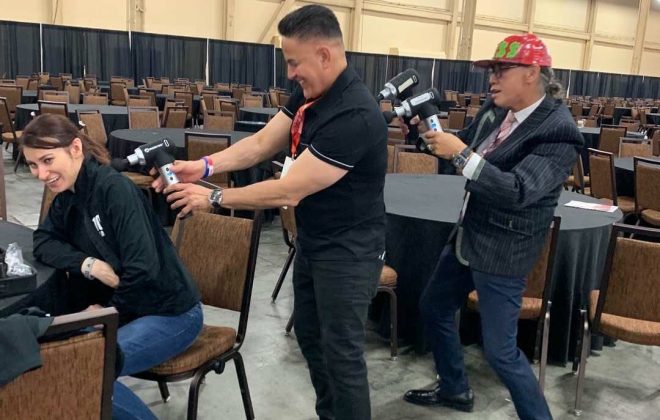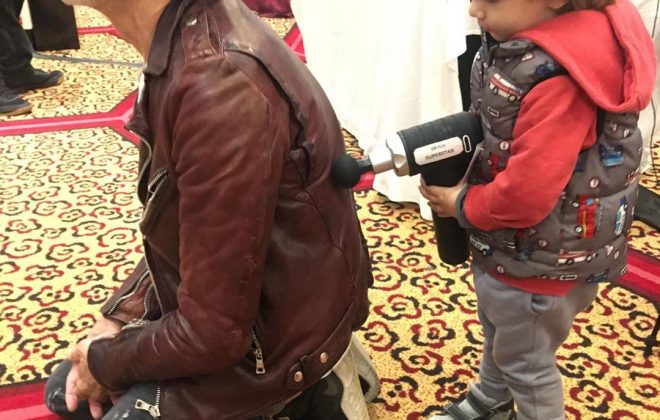Human Kinetics – Athletic Therapy Today
The Deep Muscle Stimulator’s Effects on Tissue Stiffness in Trigger-Point Therapy
THE DEEP MUSCLE STIMULATOR (DMS) is a fairly new modality that provides a deep massaging of the muscles. The developers of the DMS claim that it can relax tight muscles, which might, in turn, lead to increased range of motion and blood flow to the area. Indications for its use include scar tissue, muscle spasm, muscle soreness, acute and chronic pain, and trigger points.
The focus of this column is on an investigation into the DMS’s ability to decrease the tissue stiffness surrounding a trigger point. The DMS provides a comfortable gentle massage to the muscles being treated. Thus, an athletic therapist might be able to perform a treatment over a trigger point that will effectively increase the pain threshold of the patient and decrease the stiffness of the trigger point.
Trigger points are very sensitive areas in the muscle and fascia about the size of a pea.1 They have been given many names, some labeled according to their texture (e.g., nodules, muscle callus) and others according to the sensation elicited when touched with deep pressure (e.g., tender point, motor point, Ah Shi).
Trigger points can be the result of chronic strain, trauma, daily stresses, or even bad postural habits. They can occur in most muscles of the body but most often occur at the end plate or attachments of the muscles.2 The resultant taut bands in the muscle can often refer pain to other parts of the body through the autonomic nervous system.2
Methods
Twelve healthy volunteers participated in this study. In all, 50 trigger points were measured. Inclusion criteria included having multiple trigger points somewhere on the body. Exclusion criteria included ecchymosis, infection, open wound, rash, swelling, deficits in sensation in the treatment area, decreased circulation in the treatment area, the presence of a pacemaker, or pregnancy.
A pressure algometer was used to measure depth and pressure. The pressure algometer consisted of a force-gauge dial that measured force in kilograms from 0 to 7.7 kg. A needle showing the force would move in concert with the amount of force applied. The needle was reset to zero by manually pressing a button on the side of the force dial. The force dial was attached to a metal rod that was marked in millimeters. At the base of the rod was a plastic footplate that would lie flush with the skin. As pressure was applied, the rod would slide through the footplate, resulting in a depth ranging from 0 to 80 mm. After the measurement had been completed, the footplate was manually reset at the tip of the rod by pushing it back to the starting position.
As participants entered the room they were screened for trigger points by having them point to tender points on the body. The researcher would then have the participant lie prone on the treatment table. The trigger points were then found in the muscle and marked with an “X” using a red permanent marker. The pressure algometer was placed so that the rod (in the middle of the footplate) was directly over the X indicating the trigger point. The depth and pressure were then taken by use of the pressure algometer. The participants were instructed to verbally indicate the point of “unbearable pain.” At this point, the pressure and depth were recorded.
Participants were then given a 1-min treatment with the DMS directly over the trigger point. The researcher was careful to apply no pressure with the stimulator but only allow the weight of the unit to provide the needed force for the massaging effect. After the 1-min treatment with the stimulator, the pressure algometer was again used to determine depth and pressure. The participants were again instructed to verbally indicate the point of pain threshold. Pressure and depth were again recorded by the examiner.
Depth and pressure results were analyzed using a paired t test. Alpha was set at p < .05. Data were analyzed using SAS statistical computing software (SAS Institute Inc, Cary, NC).
Results
The mean pretreatment pressure (4.2 ± 1.5 kg) was significantly different from the mean posttreatment pressure (6.2 ± 3.3 kg, p < .0001). Likewise, mean pretreatment depth (20.4 ± 5.6 mm) was significantly different from the mean posttreatment depth (24.2 ± 5.4 mm, p < .0001). The results show that there was an immediate increase in pressure and depth after the stimulator was applied.
This means that the trigger point softened so that two things could occur. First, the participant was able to withstand more pressure from the force dial. Second, the plastic-tipped metal rod was able to go further into the tissue.
Practical Applications
Like any modality, the DMS has some contraindications. It should not be used over eyes, teeth, breast implants, cancerous areas, reproductive organs, electrical devices, screws or plates, prostheses, or healing fractures or on patients under 16 years of age or pregnant.
In summary, the Deep Muscle Stimulator is another modality available for athletic therapists’ needs. Although this study showed it to be capable of reducing the tenderness of trigger points, its effects on scar tissue, muscle soreness, range of motion, and acute and chronic pain remain untested.
References
- D’Ambrogio KJ, Roth GB. Positional Release Therapy: Assessment and Treatment of Musculoskeletal Dysfunction. St Louis, Mo: Mosby Inc; 1997.
- Travell JG, Simons DG, Simons LS. Travell and Simons’ Myofascial Pain and Dysfunction: The Trigger Point Manual. 2nd ed. Baltimore, Md: Williams & Wilkins; 1999.
David Draper is a professor of athletic training/sports medicine in the Department of Exercise Sciences at Brigham Young University, Provo, UT.





